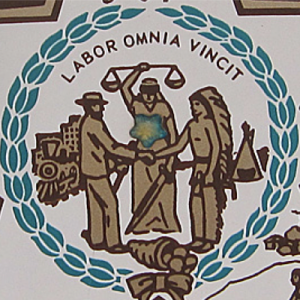|
...[W]e shall push our trading houses, and be glad to see the good and influential individuals among them run in debt, because we observe that when these debts get beyond what these individuals can pay, they become willing to lop them off by a cession of lands.
Thomas Jefferson to WIlliam Henry Harrison, February 1803 |
In the westward expansion of the US, trade preceded “settlement.” Before pioneers arrived at the borders of Indigenous nations, traders had moved beyond those borders to live among, and make a living from, Indigenous people. Traders were agents of the colonialist enterprise, but some arrived in Indigenous nations as immigrants: they learned the local languages, married into local societies and, especially in matrilineal societies, raised their children to be community leaders.
Because they could help navigate relations with colonialist powers, fur traders often gained positions of trust and social status in their new homelands. They might also arrive with formal roles among the Spanish, British, French or Americans: jobs as government agents, or licenses that sanctioned their trade. So the traders were often navigating their own complicated sets of allegiances to their new homelands and their families there, to the societies in which they were born, and most often of all to the impulse that led them beyond the settled areas in the first place: their own material gain.
The US, more than any other colonialist power, exploited the position of fur traders in pursuing a trade policy aimed at acquiring Indigenous land. As Jefferson wrote, the object was to create a dependence on trade goods, and through that dependence, generate debt among Indigenous people. Over time, the process was refined to a science. When the local fur trade became strained by over-hunting, white traders would raise the price of trade goods exponentially, and then offer unlimited credit to their Indigenous trading partners. When the US was ready to acquire Indigenous land, the traders would suddenly cut off the credit; Indigenous nations, unable to return to traditional ways of life based on hunting, could not maneuver in a new cash economy because of their debt. Trade thus created tremendous pressure to cede land. The US typically structured the payment for these cessions in annuities: relatively small annual deliveries of cash and goods that kept Indigenous nations in chronic poverty. |

Detail: Great Seal of the State of Oklahoma
"The Sioux Treaties and the Traders" (L. Kane, Minnesota History, 1951) illustrates the involvement of fur traders in treaty making. Read it here.
|
|
The Fur Trade
The fur trade generated enormous profits for colonialist traders. Before the war of 1812, the trade was controlled by family dynasties: the Ewings, Conners, Kinzies, and Godfroys in the Northeast: the Chouteaus and allied families in the West. These power structures stayed in place as the American Fur Company subsumed the family businesses into its own operations and merged with the Chouteau family, who continued to run the fur trade west of the Mississippi. The most influential fur traders - Astor and the Chouteaus - supplied the fur trade. They had the capital to purchase and transport trade goods that were exchanged for furs, making a profit on both sides of fur trade transactions.
To maintain their fortunes, fur trade companies fostered close relationships with politicians who could grant licenses and set policies that were preferential to certain traders. In exchange, the politicians could rely on fur traders to help negotiate treaties. The relationship was marked by corruption and nepotism. Traders were so influential in US-Indian policy that they were present at 3 out of every 4 treaties. |
Some US Treaty Signers who owned
fur trading companies:
|
